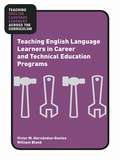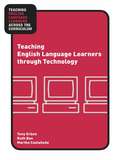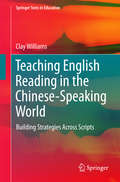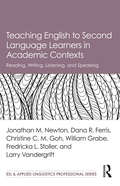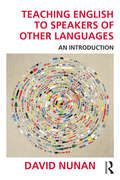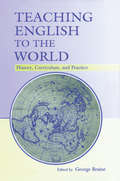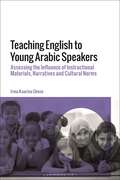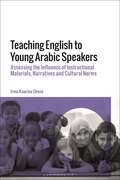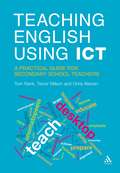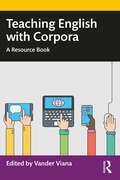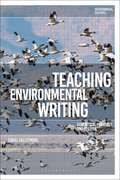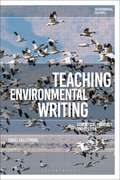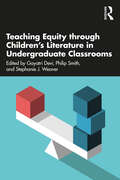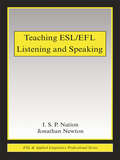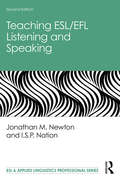- Table View
- List View
Teaching English Language Learners in Career and Technical Education Programs
by Victor M. Hernández-Gantes William BlankExploring the unique challenges of vocational education, this book provides simple and straightforward advice on how to teach English Language Learners in today's Career and Technical Education programs. The authors' teaching framework and case studies draw from common settings in which career and technical educators find themselves working with ELLs—in the classroom, in the laboratory or workshop, and in work-based learning settings. By integrating CTE and academic instruction, and embedding career development activities across the curriculum, readers will gain a better understanding of the challenges of teaching occupationally-oriented content to a diverse group of learners in multiples settings.
Teaching English Language Learners through Technology
by Tony Erben Ruth Ban Martha CastañedaIn Teaching English Language Learners through Technology, the authors explore the use of computers/technology as a pedagogical tool to aid in the appropriate instruction of ELLs across all content areas. The special focus of this book is on the informed use of various technologies and software programs that can specifically aid ELLs. Strategies are also provided for varying levels of access--whether teachers teach in a one computer classroom, have access to multiple computers, or have the ability to go into a computer lab at their school. A fully annotated list of web and print resources completes the volume, making this a valuable reference to help teachers harness the power of computer-assisted technologies in meeting the challenges of including all learners in effective instruction.
Teaching English Language Learners through Technology
by Tony Erben Ruth Ban Martha CastañedaIn Teaching English Language Learners through Technology, the authors explore the use of computers/technology as a pedagogical tool to aid in the appropriate instruction of ELLs across all content areas. The special focus of this book is on the informed use of various technologies and software programs that can specifically aid ELLs. Strategies are also provided for varying levels of access--whether teachers teach in a one computer classroom, have access to multiple computers, or have the ability to go into a computer lab at their school. A fully annotated list of web and print resources completes the volume, making this a valuable reference to help teachers harness the power of computer-assisted technologies in meeting the challenges of including all learners in effective instruction.
Teaching English Reading in the Chinese-Speaking World: Building Strategies Across Scripts (Springer Texts in Education)
by Clay WilliamsThis book investigates inherent, structural differences in the Chinese and English writing systems which predispose learners from childhood to develop specific literacy-learning strategies, which can impair later efforts at learning foreign language literacy if the foreign language script varies significantly from the native language script. It compares educational practices and philosophies in Chinese and English-speaking classrooms, and examines the psychological underpinnings of these literacy learning strategies. This book presents psychometric testing of adult reading strategy defaults and examines case study data, revealing that Chinese students are susceptible to misapplying Chinese character-level processing strategies to English word identification tasks, which decreases reading efficiency, and ultimately can lead to learning failure. Finally, a new educational framework is proposed for teaching beginning language-specific word identification and literacy-learning skills to learners whose first language script varies significantly from that of the target language.
Teaching English to Second Language Learners in Academic Contexts: Reading, Writing, Listening, and Speaking (ESL & Applied Linguistics Professional Series)
by Jonathan M. Newton Dana R. Ferris Christine C.M. Goh William Grabe Fredricka L. Stoller Larry VandergriftTeaching English to Second Language Learners in Academic Contexts: Reading, Writing, Listening, and Speaking provides the fundamental knowledge that ESL and EFL teachers need to teach the four language skills. This foundational text, written by internationally renowned experts in the field, explains why skills-based teaching is at the heart of effective instruction in English for academic purposes (EAP) contexts. Each of the four main sections of the book helps readers understand how each skill—reading, writing, listening, and speaking—works and explains what research has to say about successful skill performance. Pedagogically focused chapters apply this information to principles for EAP curriculum design and to instructional activities and tasks adaptable in a wide range of language-learning contexts. Options for assessment and the role of digital technologies are considered for each skill, and essential information on integrated-skill instruction is provided. Moving from theory to practice, this teacher-friendly text is an essential resource for courses in TESOL programs, for in-service teacher-training seminars, and for practicing EAP teachers who want to upgrade their teaching abilities and knowledge bases.
Teaching English to Second Language Learners in Academic Contexts: Reading, Writing, Listening, and Speaking (ESL & Applied Linguistics Professional Series)
by Jonathan M. Newton Dana R. Ferris Christine C.M. Goh William Grabe Fredricka L. Stoller Larry VandergriftTeaching English to Second Language Learners in Academic Contexts: Reading, Writing, Listening, and Speaking provides the fundamental knowledge that ESL and EFL teachers need to teach the four language skills. This foundational text, written by internationally renowned experts in the field, explains why skills-based teaching is at the heart of effective instruction in English for academic purposes (EAP) contexts. Each of the four main sections of the book helps readers understand how each skill—reading, writing, listening, and speaking—works and explains what research has to say about successful skill performance. Pedagogically focused chapters apply this information to principles for EAP curriculum design and to instructional activities and tasks adaptable in a wide range of language-learning contexts. Options for assessment and the role of digital technologies are considered for each skill, and essential information on integrated-skill instruction is provided. Moving from theory to practice, this teacher-friendly text is an essential resource for courses in TESOL programs, for in-service teacher-training seminars, and for practicing EAP teachers who want to upgrade their teaching abilities and knowledge bases.
Teaching English to Speakers of Other Languages: An Introduction
by David NunanDavid Nunan’s dynamic learner-centered teaching style has informed and inspired countless TESOL educators around the world. In this fresh, straightforward introduction to teaching English to speakers of other languages he presents teaching techniques and procedures along with the underlying theory and principles. Complex theories and research studies are explained in a clear and comprehensible, yet non-trivial, manner without trivializing them. Practical examples of how to develop teaching materials and tasks from sound principles provide rich illustrations of theoretical constructs. The content is presented through a lively variety of different textual genres including classroom vignettes showing language teaching in action, question and answer sessions, and opportunities to ‘eavesdrop’ on small group discussions among teachers and teachers in preparation. Readers get involved through engaging, interactive pedagogical features and opportunities for reflection and personal application. Each chapter follows the same format so that readers know what to expect as they work through the text. Key terms are defined in a Glossary at the end of the book. David Nunan’s own reflections and commentaries throughout enrich the direct, up-close style of the text.
Teaching English to Speakers of Other Languages: An Introduction
by David NunanDavid Nunan’s dynamic learner-centered teaching style has informed and inspired countless TESOL educators around the world. In this fresh, straightforward introduction to teaching English to speakers of other languages he presents teaching techniques and procedures along with the underlying theory and principles. Complex theories and research studies are explained in a clear and comprehensible, yet non-trivial, manner without trivializing them. Practical examples of how to develop teaching materials and tasks from sound principles provide rich illustrations of theoretical constructs. The content is presented through a lively variety of different textual genres including classroom vignettes showing language teaching in action, question and answer sessions, and opportunities to ‘eavesdrop’ on small group discussions among teachers and teachers in preparation. Readers get involved through engaging, interactive pedagogical features and opportunities for reflection and personal application. Each chapter follows the same format so that readers know what to expect as they work through the text. Key terms are defined in a Glossary at the end of the book. David Nunan’s own reflections and commentaries throughout enrich the direct, up-close style of the text.
Teaching English to the World: History, Curriculum, and Practice
by George BraineTeaching English to the World: History, Curriculum, and Practice is a unique collection of English language teaching (ELT) histories, curricula, and personal narratives from non-native speaker (NNS) English teachers around the world. No other book brings such a range of international ELT professionals together to describe and narrate what they know best.The book includes chapters from Brazil, China, Germany, Hong Kong, Hungary, India, Indonesia, Israel, Japan, Lebanon, Poland, Saudi Arabia, Singapore, Sri Lanka, and Turkey. All chapters follow a consistent pattern, describing first the history of English language teaching in a particular country, then the current ELT curriculum, followed by the biography or the autobiography of an English teacher of that country. This consistency in the structuring of chapters will enable readers to assimilate the information easily while also comparing and contrasting the context of ELT in each country.The chapter authors--all born in or residents of the countries they represent and speakers of the local language or languages as well as English--provide insider perspectives on the challenges faced by local English language teachers. There is clear evidence that the majority of English teachers worldwide are nonnative speakers (NNS), and there is no doubt that many among them have been taught by indigenous teachers who themselves are nonnative speakers. This book brings the professional knowledge and experience of these teachers and the countries they represent to a mainstream Western audience including faculty, professionals, and graduate students in the field of ESL; to the international TESOL community; and to ELT teachers around the world.
Teaching English to the World: History, Curriculum, and Practice
by George BraineTeaching English to the World: History, Curriculum, and Practice is a unique collection of English language teaching (ELT) histories, curricula, and personal narratives from non-native speaker (NNS) English teachers around the world. No other book brings such a range of international ELT professionals together to describe and narrate what they know best.The book includes chapters from Brazil, China, Germany, Hong Kong, Hungary, India, Indonesia, Israel, Japan, Lebanon, Poland, Saudi Arabia, Singapore, Sri Lanka, and Turkey. All chapters follow a consistent pattern, describing first the history of English language teaching in a particular country, then the current ELT curriculum, followed by the biography or the autobiography of an English teacher of that country. This consistency in the structuring of chapters will enable readers to assimilate the information easily while also comparing and contrasting the context of ELT in each country.The chapter authors--all born in or residents of the countries they represent and speakers of the local language or languages as well as English--provide insider perspectives on the challenges faced by local English language teachers. There is clear evidence that the majority of English teachers worldwide are nonnative speakers (NNS), and there is no doubt that many among them have been taught by indigenous teachers who themselves are nonnative speakers. This book brings the professional knowledge and experience of these teachers and the countries they represent to a mainstream Western audience including faculty, professionals, and graduate students in the field of ESL; to the international TESOL community; and to ELT teachers around the world.
Teaching English to Young Arabic Speakers: Assessing the Influence of Instructional Materials, Narratives and Cultural Norms
by Irma-Kaarina GhosnThe book explores young Arabic-speaking children's English language learning. Through classroom-based research and learner work samples, the book analyses the interplay between cultural norms and the critical role that teachers play in orchestrating classroom discourse through skillful use of available instructional materials, questioning strategies and feedback to learners. The author shows the potential of instructional materials to influence young learners' vocabulary, reading comprehension, and written production, as well as the way they acquire the academic literacies needed in school subjects taught in English. She reviews the spread of the practice of teaching English to young and very young children and the increasing demand for English-medium instruction in the Arabic-speaking region, with a particular focus on the negative transfer from Arabic to English spelling and grammar. The book also discusses the importance of story narratives, arguing they are an ideal medium for language teaching because of their rich linguistic repertoire and the strong motivational force that stories have on young language learners and their cognitive growth, essential to their later academic success. Taken together, the research findings and classroom vignettes suggest that children's language learning happens within a complex system of interactive variables and cultural norms and expectations.
Teaching English to Young Arabic Speakers: Assessing the Influence of Instructional Materials, Narratives and Cultural Norms
by Irma-Kaarina GhosnThe book explores young Arabic-speaking children's English language learning. Through classroom-based research and learner work samples, the book analyses the interplay between cultural norms and the critical role that teachers play in orchestrating classroom discourse through skillful use of available instructional materials, questioning strategies and feedback to learners. The author shows the potential of instructional materials to influence young learners' vocabulary, reading comprehension, and written production, as well as the way they acquire the academic literacies needed in school subjects taught in English. She reviews the spread of the practice of teaching English to young and very young children and the increasing demand for English-medium instruction in the Arabic-speaking region, with a particular focus on the negative transfer from Arabic to English spelling and grammar. The book also discusses the importance of story narratives, arguing they are an ideal medium for language teaching because of their rich linguistic repertoire and the strong motivational force that stories have on young language learners and their cognitive growth, essential to their later academic success. Taken together, the research findings and classroom vignettes suggest that children's language learning happens within a complex system of interactive variables and cultural norms and expectations.
Teaching English to Young Learners: Critical Issues in Language Teaching with 3-12 Year Olds
by Janice BlandAimed at student teachers, educators and practitioners, Teaching English Language to Young Learners outlines and explains the crucial issues, themes and scenarios relating to this area of teaching. Each chapter by a leading international scholar offers a thorough introduction to a central theme of English as a foreign language (EFL) with preteens, with clear presentation of the theoretical background and detailed references for further reading, providing access to the most recent scholarship. Exploring the essential issues critically and in-depth, including the disadvantages as well as advantages of Teaching English as a Foreign Language (TEFL) with young learners, topics include: - task-based learning in the primary school;- storytelling;- drama;- technology;- vocabulary development;- intercultural understanding; - Content and Language Integrated Learning (CLIL) scenarios;- assessment.Innovative and rapidly emerging topics are covered, such as immersion teaching, picturebooks in the EFL classroom and English with pre-primary children.
Teaching English to Young Learners: Critical Issues in Language Teaching with 3-12 Year Olds
by Janice BlandAimed at student teachers, educators and practitioners, Teaching English Language to Young Learners outlines and explains the crucial issues, themes and scenarios relating to this area of teaching. Each chapter by a leading international scholar offers a thorough introduction to a central theme of English as a foreign language (EFL) with preteens, with clear presentation of the theoretical background and detailed references for further reading, providing access to the most recent scholarship. Exploring the essential issues critically and in-depth, including the disadvantages as well as advantages of Teaching English as a Foreign Language (TEFL) with young learners, topics include: - task-based learning in the primary school;- storytelling;- drama;- technology;- vocabulary development;- intercultural understanding; - Content and Language Integrated Learning (CLIL) scenarios;- assessment.Innovative and rapidly emerging topics are covered, such as immersion teaching, picturebooks in the EFL classroom and English with pre-primary children.
Teaching English Using ICT: A Practical Guide for Secondary School Teachers
by Tom Rank Trevor Millum Chris WarrenWant to get boys excited about poetry? Try establishing a wiki-war on the use of form and structure. Or perhaps a podcast to develop close analysis of language. How about getting them blogging about their favourite characters? Based on established principles of the best ways to use ICT in English, this practical resource looks at when and how ICT can be used to engage and inspire students of English, but only when it enhances teaching and learning, never for its own sake. Beginning with an overview of what ICT can offer and how it is changing the way we teach and learn, the authors then give practical examples of activities and ideas to attain key English skills and learning goals in secondary schools. Throughout the book, there are tried-and-tested ideas for tackling the hard-to-teach topics, and there is also a dedicated website with links to useful websites, the authors' favourite tips and downloadable resources.
Teaching English Using ICT: A Practical Guide for Secondary School Teachers
by Tom Rank Trevor Millum Chris WarrenWant to get boys excited about poetry? Try establishing a wiki-war on the use of form and structure. Or perhaps a podcast to develop close analysis of language. How about getting them blogging about their favourite characters? Based on established principles of the best ways to use ICT in English, this practical resource looks at when and how ICT can be used to engage and inspire students of English, but only when it enhances teaching and learning, never for its own sake. Beginning with an overview of what ICT can offer and how it is changing the way we teach and learn, the authors then give practical examples of activities and ideas to attain key English skills and learning goals in secondary schools. Throughout the book, there are tried-and-tested ideas for tackling the hard-to-teach topics, and there is also a dedicated website with links to useful websites, the authors' favourite tips and downloadable resources.
Teaching English with Corpora: A Resource Book
by Vander VianaTeaching English with Corpora is an accessible and practical introduction to the ways in which online and offline corpora can be used in English language teaching (ELT). Featuring 70 chapters written by an international range of researchers and practitioners, this book: • provides readers with clear, tested examples of corpus-based/driven lesson plans; • contains activities relevant to English for general purposes and English for specific purposes; • caters for the needs of English language teachers working with learners at different proficiency levels; • features flexible teaching suggestions that can be explored as part of a lesson or as a full lesson. This book is an essential purchase for pre- and in-service English language teachers as well as those studying corpus linguistics in undergraduate/Master’s courses in applied linguistics, ELT and Teaching English to Speakers of Other Languages (TESOL).
Teaching English with Corpora: A Resource Book
by Vander VianaTeaching English with Corpora is an accessible and practical introduction to the ways in which online and offline corpora can be used in English language teaching (ELT). Featuring 70 chapters written by an international range of researchers and practitioners, this book: • provides readers with clear, tested examples of corpus-based/driven lesson plans; • contains activities relevant to English for general purposes and English for specific purposes; • caters for the needs of English language teachers working with learners at different proficiency levels; • features flexible teaching suggestions that can be explored as part of a lesson or as a full lesson. This book is an essential purchase for pre- and in-service English language teachers as well as those studying corpus linguistics in undergraduate/Master’s courses in applied linguistics, ELT and Teaching English to Speakers of Other Languages (TESOL).
Teaching Environmental Writing: Ecocritical Pedagogy and Poetics (Environmental Cultures)
by Isabel GalleymoreEnvironmental writing is an increasingly popular literary genre, and a multifaceted genre at that. Recently dominated by works of 'new nature writing', environmental writing includes works of poetry and fiction about the world around us. In the last two decades, universities have begun to offer environmental writing modules and courses with the intention of teaching students skills in the field of writing inspired by the natural world. This book asks how students are being guided into writing about environments. Informed by independently conducted interviews with educators, and a review of existing pedagogical guides, it explores recurring instructions given to students for writing about the environment and compares these pedagogical approaches to the current theory and practice of ecocriticism by scholars such as Ursula Heise and Timothy Morton. Proposing a set of original pedagogical exercises influenced by ecocriticism, the book draws on a number of self-reflexive, environmentally-conscious poets, including Juliana Spahr, Jorie Graham and Les Murray, as creative and stimulating models for teachers and students.
Teaching Environmental Writing: Ecocritical Pedagogy and Poetics (Environmental Cultures)
by Isabel GalleymoreEnvironmental writing is an increasingly popular literary genre, and a multifaceted genre at that. Recently dominated by works of 'new nature writing', environmental writing includes works of poetry and fiction about the world around us. In the last two decades, universities have begun to offer environmental writing modules and courses with the intention of teaching students skills in the field of writing inspired by the natural world. This book asks how students are being guided into writing about environments. Informed by independently conducted interviews with educators, and a review of existing pedagogical guides, it explores recurring instructions given to students for writing about the environment and compares these pedagogical approaches to the current theory and practice of ecocriticism by scholars such as Ursula Heise and Timothy Morton. Proposing a set of original pedagogical exercises influenced by ecocriticism, the book draws on a number of self-reflexive, environmentally-conscious poets, including Juliana Spahr, Jorie Graham and Les Murray, as creative and stimulating models for teachers and students.
Teaching Equity through Children’s Literature in Undergraduate Classrooms
by Gayatri Devi Philip Smith Stephanie J. WeaverChildren's literature has been taught in undergraduate classrooms since the mid-1960s and has grown to become a staple of English literature, library science, and education programs. Children's literature classes are typically among the most popular course offerings at any institution. It is easy to understand why; children's literature classes promise students the opportunity to revisit familiar works with fresh eyes. With the growth of the children’s publishing industry and the celebration of recent scholarly interventions in the field, the popularity of the discipline is unlikely to abate. A central question of current children’s literature scholarship and practice is how to effectively address contemporary questions of social justice. This collection offers a series of interventions for the practice of teaching equity through children's literature in undergraduate classrooms. It is intended for individuals who teach, or who are interested in teaching, children’s literature to undergraduates. It includes contributions from practitioners from a range of institutional affiliations, disciplinary backgrounds, nationalities, and career stages. Furthermore, this volume includes contributions from scholars who belong to groups which are often underrepresented within academia, due to race, nationality, ethnicity, gender identity, disability, or other protected characteristics.
Teaching Equity through Children’s Literature in Undergraduate Classrooms
by Gayatri Devi Philip Smith Stephanie J. WeaverChildren's literature has been taught in undergraduate classrooms since the mid-1960s and has grown to become a staple of English literature, library science, and education programs. Children's literature classes are typically among the most popular course offerings at any institution. It is easy to understand why; children's literature classes promise students the opportunity to revisit familiar works with fresh eyes. With the growth of the children’s publishing industry and the celebration of recent scholarly interventions in the field, the popularity of the discipline is unlikely to abate. A central question of current children’s literature scholarship and practice is how to effectively address contemporary questions of social justice. This collection offers a series of interventions for the practice of teaching equity through children's literature in undergraduate classrooms. It is intended for individuals who teach, or who are interested in teaching, children’s literature to undergraduates. It includes contributions from practitioners from a range of institutional affiliations, disciplinary backgrounds, nationalities, and career stages. Furthermore, this volume includes contributions from scholars who belong to groups which are often underrepresented within academia, due to race, nationality, ethnicity, gender identity, disability, or other protected characteristics.
Teaching ESL/EFL Listening and Speaking (ESL & Applied Linguistics Professional Series)
by I.S.P. Nation Jonathan NewtonUsing a framework based on principles of teaching and learning, this guide for teachers and teacher trainees provides a wealth of suggestions for helping learners at all levels of proficiency develop their listening and speaking skills and fluency. By following these suggestions, which are organized around four strands – meaning-focused input, meaning-focused output, language-focused learning, and fluency development – teachers will be able to design and present a balanced program for their students. Teaching ESL/EFL Listening and Speaking, and its companion text, Teaching ESL/EFL Reading and Writing, are similar in format and the kinds of topics covered, but do not need to be used together. Drawing on research and theory in applied linguistics, their focus is strongly hands-on, featuring easily applied principles, a large number of useful teaching techniques, and guidelines for testing and monitoring. All Certificate, Diploma, Masters and Doctoral courses for teachers of English as a second or foreign language include a teaching methods component. The texts are designed for and have been field tested in such programs.
Teaching ESL/EFL Listening and Speaking (ESL & Applied Linguistics Professional Series)
by I.S.P. Nation Jonathan NewtonUsing a framework based on principles of teaching and learning, this guide for teachers and teacher trainees provides a wealth of suggestions for helping learners at all levels of proficiency develop their listening and speaking skills and fluency. By following these suggestions, which are organized around four strands – meaning-focused input, meaning-focused output, language-focused learning, and fluency development – teachers will be able to design and present a balanced program for their students. Teaching ESL/EFL Listening and Speaking, and its companion text, Teaching ESL/EFL Reading and Writing, are similar in format and the kinds of topics covered, but do not need to be used together. Drawing on research and theory in applied linguistics, their focus is strongly hands-on, featuring easily applied principles, a large number of useful teaching techniques, and guidelines for testing and monitoring. All Certificate, Diploma, Masters and Doctoral courses for teachers of English as a second or foreign language include a teaching methods component. The texts are designed for and have been field tested in such programs.
Teaching ESL/EFL Listening and Speaking (ESL & Applied Linguistics Professional Series)
by Jonathan M. Newton I.S.P. NationThis guide for teachers and teacher trainees provides a wealth of suggestions for helping learners at all levels of proficiency develop their listening and speaking skills and fluency, using a framework based on principles of teaching and learning. By following these suggestions, which are organized around four strands – meaning-focused input, meaning-focused output, language-focused learning, and fluency development – teachers will be able to design and present a balanced program for their students. Updated with cutting-edge research and theory, the Second Edition of Teaching ESL/EFL Listening and Speaking retains its hands-on focus and engaging format, and features new activities and information on emerging topics, including: Two new chapters on Extensive Listening and Teaching Using a Course Book Expanded coverage of key topics, including assessment, pronunciation, and using the internet to develop listening and speaking skills Easy-to-implement tasks and suggestions for further reading in every chapter More tools for preservice teachers and teacher trainers, such as a sample unit, a "survival syllabus," and topic prompts The second edition of this bestselling book is an essential text for all Certificate, Diploma, Masters and Doctoral courses for teachers of English as a second or foreign language.
